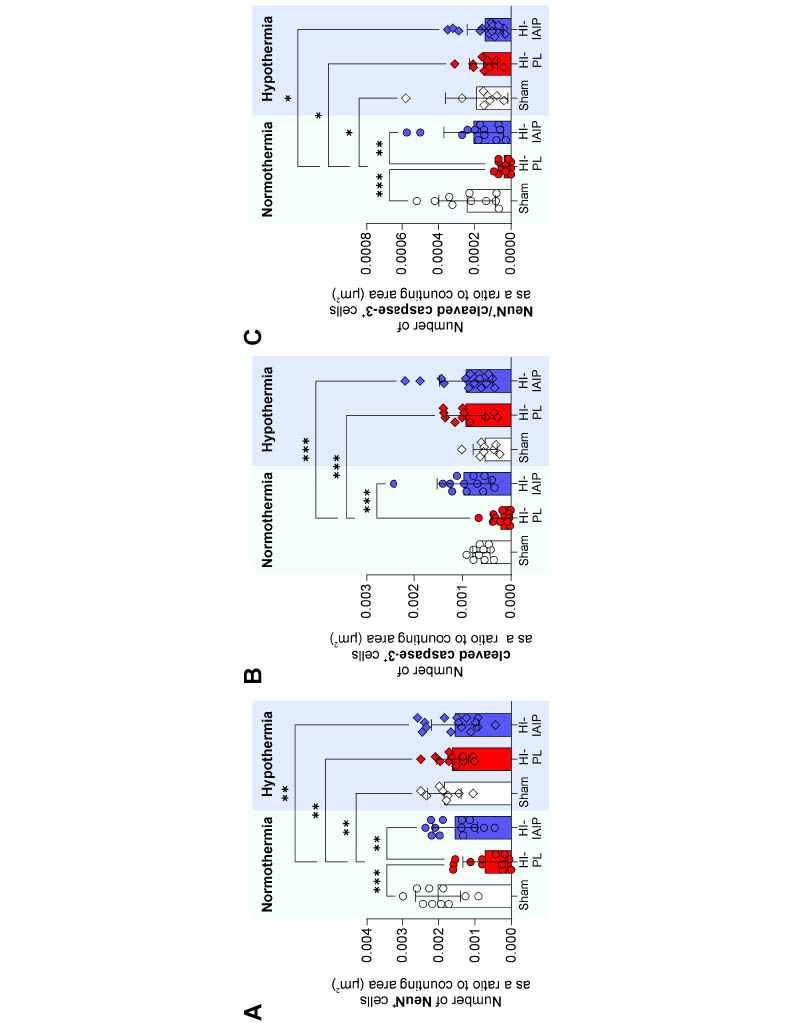Neonatal Neurology 7: Pre-Clinical 1
Session: Neonatal Neurology 7: Pre-Clinical 1
009 - Protective Effects of Inter-alpha Inhibitor Proteins and Hypothermia on Neuronal Apoptosis Following Hypoxic-Ischemic Brain Injury in Neonatal Rats
Monday, April 28, 2025
7:00am - 9:15am HST
Publication Number: 9.6456
Zexi Zang, Women & Infants Hospital of Rhode Island, Providence, RI, United States; Tuong Tran, Brown University, San Francisco, CA, United States; Bingqing Wang, Women & Infants Hospital of Rhode Island, PROVIDENCE, RI, United States; Kevin V. Nguyen, Icahn School of Medicine at Mount Sinai, New York, NY, United States; Alix Hamon, Women & Infants Hospital of Rhode Island, Providence, RI, United States; Yow-Pin Lim, The Warren Alpert Medical School of Brown University, Providence, RI, United States; Barbara Stonestreet, The Warren Alpert Medical School of Brown University, Providence, RI, United States; Xiaodi F. Chen, The Warren Alpert Medical School of Brown University, Barrington, RI, United States

Zexi Zang, Master's (he/him/his)
Research Assistant
Women & Infants Hospital of Rhode Island
Providence, Rhode Island, United States
Presenting Author(s)
Background: Hypoxic-ischemic (HI) brain injury is a significant cause of neonatal morbidity. Hypothermia, the only FDA-approved treatment, provides partial protection within a narrow therapeutic window. Inter-alpha inhibitor proteins (IAIPs) are naturally occurring immunomodulatory molecules that show promise in reducing brain infarct volume in neonates exposed to HI, demonstrating effects comparable to hypothermia, with enhanced protection in females when the two are combined. Apoptosis contributes to neuronal loss in neonatal HI brain injury. However, the mechanisms by which hypothermia and IAIPs influence HI-related neuronal apoptosis remain unexplored.
Objective: To investigate the effects of IAIPs and hypothermia on neuronal apoptosis in neonatal rats after HI injury.
Design/Methods: Postnatal day (P7) rats were randomly assigned to six groups: Normothermia Sham-Placebo (Norm_Sham), Normothermia HI-Placebo (Norm_HI-PL), Normothermia HI-IAIP (Norm_HI-IAIP), Hypothermia Sham-Placebo (Hypo_Sham), Hypothermia HI-Placebo (Hypo_HI-PL), and Hypothermia HI-IAIP (Hypo_HI-IAIP). Rats underwent right carotid artery ligation followed by hypoxia (90 min of 8% O2). IAIPs (60 mg/kg) or PL were administered intraperitoneally at 15 min, 24, and 48 h post-HI. Normothermia (36°C) or hypothermia (30°C) was applied for 3 hours, starting 1 h post-HI. Brain tissues were analyzed at P14 using immunohistochemistry for NeuN (neuronal marker) and cleaved Caspase-3 (apoptosis marker). Data were analyzed with ANOVA or Kruskal-Wallis and appropriate post-hoc analyses.
Results: HI injury reduced the NeuN+ cell ratio in the cortex compared to Norm_Sham group. This loss was attenuated in the Norm_HI-IAIP, Hypo_HI-PL, and Hypo_HI-IAIP groups. The cleaved Caspase-3+ cell ratio was increased in the Norm_HI-IAIP, Hypo_HI-PL, and Hypo_HI-IAIP groups compared to the Norm_HI-PL group. The ratio of NeuN+ and cleaved Caspase-3+ double-labeled cells was lower in Norm_HI-PL, but increased in the Norm_HI-IAIP, Hypo_HI-PL, and Hypo_HI-IAIP groups, reaching levels comparable to the Norm_Sham group. No significant differences were observed between Hypo_HI-PL and Hypo_HI-IAIP in any cell population.
Conclusion(s): Hypothermia, IAIPs, and hypothermia+IAIPs reduced neuronal loss and rescued neuronal apoptosis 7 days post-HI in neonatal rats. These findings suggest that while IAIPs did not enhance the protective effects of hypothermia on neonatal HIE via pathways of apoptosis, IAIPs and/or hypothermia treatment may help preserve neurons and sustain physiological apoptosis levels post-HI injury, thereby contributing to reduced histopathological brain damage.
Figure
 The ratio of the number of NeuN+ (Fig. A), cleaved Caspase-3+ (Fig. B), and NeuN+/cleaved Caspase-3+ double labelled (Fig. C) cells in ipsilateral cortex to the ipsilateral cortex area in Norm_Sham (n=10), Norm_HI-PL (n=12), Norm_HI-IAIP (n=13), Hypo_Sham (n=8), Hypo_HI-PL (n=11), and Hypo_HI-IAIP (n=15) groups. Values are expressed as mean ± SD. * p < 0.05, ** p < 0.01, *** p < 0.001.
The ratio of the number of NeuN+ (Fig. A), cleaved Caspase-3+ (Fig. B), and NeuN+/cleaved Caspase-3+ double labelled (Fig. C) cells in ipsilateral cortex to the ipsilateral cortex area in Norm_Sham (n=10), Norm_HI-PL (n=12), Norm_HI-IAIP (n=13), Hypo_Sham (n=8), Hypo_HI-PL (n=11), and Hypo_HI-IAIP (n=15) groups. Values are expressed as mean ± SD. * p < 0.05, ** p < 0.01, *** p < 0.001.
